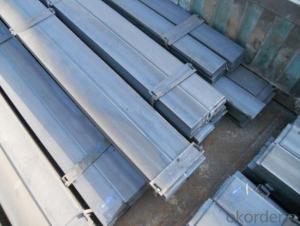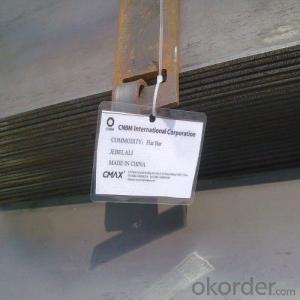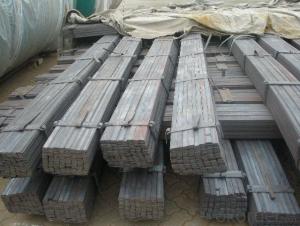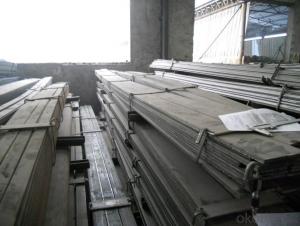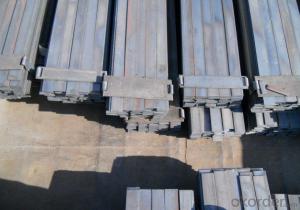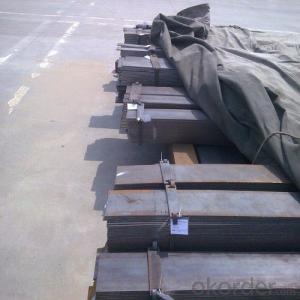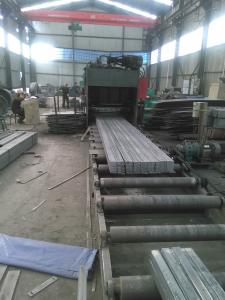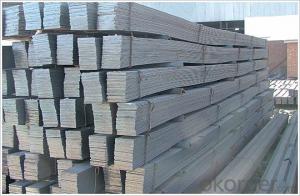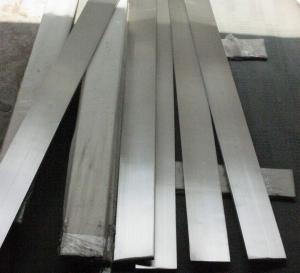Hot Rolled Flat Bars in Material Grade Q235 With Good Price
- Loading Port:
- Tianjin
- Payment Terms:
- TT OR LC
- Min Order Qty:
- 25 m.t.
- Supply Capability:
- 10000 m.t./month
OKorder Service Pledge
OKorder Financial Service
You Might Also Like
Product Description:
OKorder is offering high quality Flat Bar at great prices with worldwide shipping. Our supplier is a world-class manufacturer of steel, with our products utilized the world over. OKorder annually supplies products to European, North American and Asian markets. We provide quotations within 24 hours of receiving an inquiry and guarantee competitive prices.
Product Applications:
Flat Bars are ideal for structural applications and are widely used in the construction of buildings and bridges, and the manufacturing, petrochemical, and transportation industries.
Product Advantages:
OKorder's Flats Bar are durable, strong, and resist corrosion.
Main Product Features:
· Premium quality
· Prompt delivery & seaworthy packing (30 days after receiving deposit)
· Corrosion resistance
· Can be recycled and reused
· Mill test certification
· Professional Service
· Competitive pricing
Product Specifications:
Manufacture: Hot Rolled
Grade: Q195 – 235
Certificates: ISO, SGS, BV, CIQ
Length: 6m – 12m, as per customer request
Packaging: Export packing, nude packing, bundled
Chemical composition of Q235
Alloy No | Grade | Element(%) | ||||
C
| Mn
| S
| P
| Si
| ||
Q235
|
B
|
0.12—0.20 |
0.3—0.7 |
≤0.045 |
≤0.045
|
≤0.3
|
Physical properties of Q235
Alloy No | Grade | Yielding strength point(Mpa) | Tensile strength (Mpa) | Elongation after fracture(%) | ||||||
Thickness (mm) | Thickness (mm) | |||||||||
≤16 | >16--40 | >40--60 | >60--100 | ≤16 | >16--40 | >40--60 | >60--100 | |||
≥ | ≥ | |||||||||
Q235 |
B |
235 |
225 |
215 |
205 |
375--500 |
26 |
25 |
24 |
23 |
FAQ:
Q1: How soon can we receive the product after purchase?
A1: Within three days of placing an order, we will begin production. The specific shipping date is dependent upon international and government factors, but is typically 7 to 10 workdays.
Q2: How do we guarantee the quality of our products?
A2: We have established an advanced quality management system which conducts strict quality tests at every step, from raw materials to the final product. At the same time, we provide extensive follow-up service assurances as required.
Q3: The products are invoicing on theoritical weight or on actual weight?
A3: We can do it in both manners, according to buyers' requiremnet.
Images:
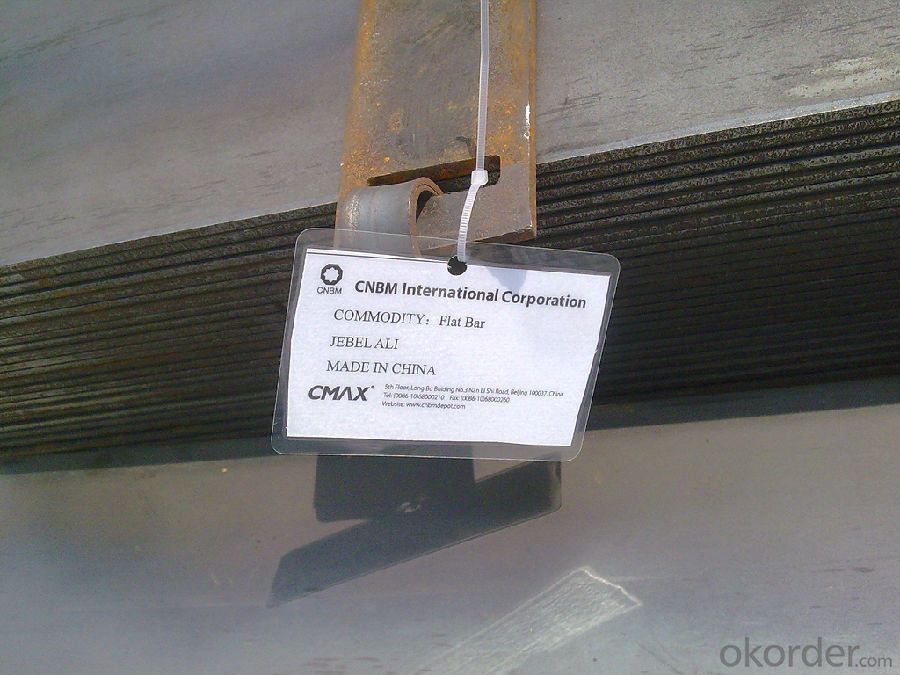
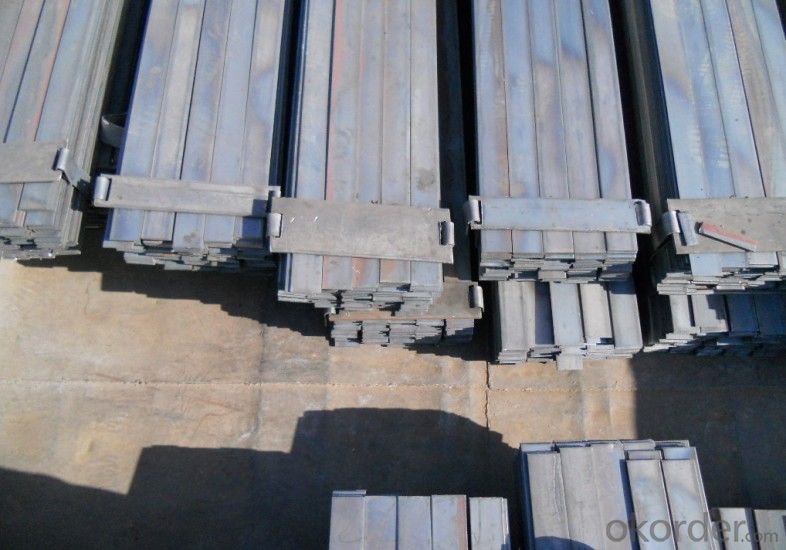
- Q:Are steel flat bars suitable for making conveyor systems?
- Certainly! Steel flat bars are indeed a fitting choice for the construction of conveyor systems. Renowned for their robustness, longevity, and capacity to bear substantial burdens, steel flat bars possess indispensable attributes for conveyor systems. They furnish a steadfast and secure foundation for the transportation of materials, effectively enduring the ceaseless motion and forceful impacts demanded by conveyor systems. Furthermore, steel flat bars can be effortlessly crafted and tailored to match the precise dimensions and contours required for the conveyor system. All in all, steel flat bars constitute a dependable and extensively employed material for the assembly of conveyor systems across diverse industries.
- Q:Are steel flat bars suitable for making brackets or supports for HVAC systems?
- Steel flat bars are a suitable choice for creating brackets or supports for HVAC systems. Due to its strength and durability, steel is capable of withstanding the weight and pressure exerted by HVAC units. The stability provided by flat bars allows for easy shaping and bending to meet the specific requirements of the brackets or supports. Moreover, steel exhibits exceptional resistance to corrosion, a crucial characteristic for HVAC systems that frequently encounter diverse environmental conditions. In summary, employing steel flat bars guarantees a dependable and enduring solution for HVAC installations.
- Q:What is the price range of steel flat bars?
- The price range of steel flat bars can vary depending on several factors such as the size, grade, and quality of the steel. Generally, the price range for steel flat bars can range from $10 to $100 per bar. However, specialty or high-grade steel flat bars can be priced higher, reaching up to $200 or more. It is recommended to consult with local suppliers or check online sources for the most accurate and up-to-date pricing information.
- Q:What are the common safety precautions when working with steel flat bars?
- When working with steel flat bars, there are several common safety precautions that should be followed to ensure the safety of the workers. 1. Personal Protective Equipment (PPE): The first and foremost precaution is to wear appropriate PPE. This includes safety glasses or goggles to protect the eyes from any flying debris or sparks, gloves to protect hands from sharp edges, and steel-toe boots to protect feet from heavy objects or falling materials. 2. Proper Lifting Techniques: Steel flat bars can be heavy, so it is important to use proper lifting techniques to prevent back or muscle injuries. Lift with your legs, not your back, and avoid twisting or jerking movements while lifting. 3. Secure Storage: When not in use, steel flat bars should be stored in a secure and organized manner. This prevents any accidental tripping or falling hazards. Additionally, heavy steel flat bars should be stored at a lower height to avoid any potential injuries caused by falling objects. 4. Safe Handling: When handling steel flat bars, it is important to be cautious of sharp edges and corners. Workers should always be mindful of their surroundings and avoid any sudden movements that could cause injury. Proper lifting equipment, such as lifting clamps or tongs, should be used when necessary to ensure a secure grip on the bars. 5. Fire Safety: Steel flat bars can produce sparks when being cut or welded. Therefore, it is essential to have a fire extinguisher nearby and ensure proper ventilation in the workspace to prevent the buildup of flammable gases or fumes. 6. Training and Education: All workers should receive proper training and education on the safe handling and use of steel flat bars. This includes understanding the correct tools and equipment to use, as well as the potential hazards associated with working with steel flat bars. By following these common safety precautions, workers can minimize the risk of accidents, injuries, and ensure a safe working environment when working with steel flat bars.
- Q:Can steel flat bars be used for making brackets or supports for automotive accessories?
- Yes, steel flat bars can be used for making brackets or supports for automotive accessories. Steel is a strong and durable material that provides excellent structural support, making it suitable for various applications in the automotive industry.
- Q:How do steel flat bars contribute to the energy efficiency of buildings?
- Steel flat bars can contribute to the energy efficiency of buildings in several ways. Firstly, steel is a highly durable material that can withstand extreme weather conditions, such as high winds and heavy rain, which can help in maintaining the structural integrity of the building over time. This durability leads to a longer lifespan for the building, reducing the need for frequent repairs or replacements, resulting in energy and cost savings. Additionally, steel flat bars are often used in the construction of windows and doors. These components play a crucial role in the energy efficiency of a building as they help to minimize heat transfer and air leakage. Steel, being a poor conductor of heat, can provide excellent insulation properties when used in window frames or door frames. This insulation helps to prevent heat loss during cold winter months and heat gain during hot summer months, reducing the reliance on heating or cooling systems and improving energy efficiency. Furthermore, steel flat bars can be used as structural elements in the building's envelope, such as in wall framing or roof trusses. The use of steel in these applications allows for the construction of lighter and stronger structures, which can facilitate the use of larger windows or open floor plans. This, in turn, promotes natural daylighting and ventilation, reducing the need for artificial lighting and mechanical ventilation systems. By maximizing the use of natural resources, steel flat bars contribute to the overall energy efficiency of the building. Lastly, steel is a recyclable material, meaning that after its use in a building, it can be easily recycled and repurposed for other applications. This promotes sustainable construction practices and reduces the overall environmental impact of the building industry. By choosing steel flat bars for construction, builders contribute to a circular economy, where materials are reused rather than disposed of, further enhancing the energy efficiency and sustainability of the building. In conclusion, steel flat bars contribute to the energy efficiency of buildings through their durability, insulation properties, structural benefits, and recyclability. By utilizing steel in various building components, builders can create more sustainable and energy-efficient structures, leading to long-term cost savings and reduced environmental impact.
- Q:What are the different heat treatment processes for steel flat bars?
- There are several heat treatment processes for steel flat bars, including annealing, quenching and tempering, normalizing, and hardening. Annealing involves heating the steel to a specific temperature and then slowly cooling it to improve its ductility and reduce internal stresses. Quenching and tempering involves heating the steel to a high temperature and then rapidly cooling it in a quenching medium to increase its hardness, followed by tempering to reduce brittleness. Normalizing is a heat treatment process similar to annealing, but with a faster cooling rate, to refine the grain structure and improve the steel's mechanical properties. Hardening is a process where the steel is heated to a high temperature and then rapidly cooled to increase its hardness and strength.
- Q:How do you store steel flat bars to prevent damage?
- To prevent damage to steel flat bars, it is recommended to store them in a dry and well-ventilated area to avoid moisture buildup and corrosion. Additionally, they should be stacked horizontally with proper support to prevent bending or warping. Using protective covers or separating each bar with wooden or rubber spacers can prevent scratching or damage from contact with other materials. Regular inspection and maintenance are also essential to ensure their longevity and quality.
- Q:Are steel flat bars suitable for making agricultural equipment?
- Yes, steel flat bars are suitable for making agricultural equipment. Steel is known for its strength and durability, making it a reliable choice for heavy-duty applications in the agricultural industry. Flat bars provide a sturdy base and can be easily shaped and welded to create various components of agricultural equipment such as plows, cultivators, and harrows. Additionally, steel's resistance to corrosion ensures that the equipment remains functional and reliable even in harsh outdoor conditions.
- Q:Can steel flat bars be used for reinforcement in concrete structures?
- Yes, steel flat bars can be used for reinforcement in concrete structures. The purpose of reinforcement in concrete is to enhance its strength and durability by providing tensile strength that concrete lacks. Steel flat bars are commonly used for this purpose due to their high tensile strength and flexibility. Steel flat bars are typically embedded in concrete to form reinforced concrete structures such as beams, columns, and slabs. They are placed strategically within the concrete to counteract the tensile forces that occur when the concrete is subjected to loads or changes in temperature. By reinforcing the concrete with steel flat bars, the overall structural integrity of the concrete is significantly improved. The steel flat bars used for reinforcement are usually made of high-strength steel, such as mild steel or carbon steel. They are manufactured to specific standards and dimensions to ensure their compatibility with concrete structures. The bars are typically cut to the required length and shape and then placed in the desired positions within the concrete formwork before the concrete is poured. The use of steel flat bars for reinforcement in concrete structures offers several advantages. Firstly, steel has a high strength-to-weight ratio, allowing for efficient reinforcement without adding excessive weight to the structure. Secondly, steel is highly durable and resistant to corrosion, which ensures the longevity of the reinforced concrete structure. Additionally, steel flat bars can be easily bent or shaped to fit the specific design requirements of the concrete structure. However, it is important to note that the design and installation of steel flat bars for reinforcement in concrete structures should be carried out by qualified professionals, such as structural engineers and construction contractors. They will consider factors such as the required strength, load-bearing capacity, and durability of the structure, as well as local building codes and regulations, to ensure the safe and effective use of steel flat bars for reinforcement.
1. Manufacturer Overview |
|
|---|---|
| Location | |
| Year Established | |
| Annual Output Value | |
| Main Markets | |
| Company Certifications | |
2. Manufacturer Certificates |
|
|---|---|
| a) Certification Name | |
| Range | |
| Reference | |
| Validity Period | |
3. Manufacturer Capability |
|
|---|---|
| a)Trade Capacity | |
| Nearest Port | |
| Export Percentage | |
| No.of Employees in Trade Department | |
| Language Spoken: | |
| b)Factory Information | |
| Factory Size: | |
| No. of Production Lines | |
| Contract Manufacturing | |
| Product Price Range | |
Send your message to us
Hot Rolled Flat Bars in Material Grade Q235 With Good Price
- Loading Port:
- Tianjin
- Payment Terms:
- TT OR LC
- Min Order Qty:
- 25 m.t.
- Supply Capability:
- 10000 m.t./month
OKorder Service Pledge
OKorder Financial Service
Similar products
New products
Hot products
Hot Searches
Related keywords
